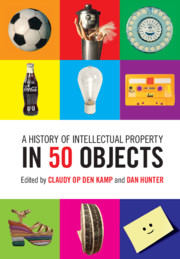Book contents
- Frontmatter
- Dedication
- Contents
- Acknowledgments
- Introduction: Of People, Places, and Parlance
- The Pre-Modern Period
- The Age of invention
- Modern Times
- 18 Player Piano Roll
- 19 Champagne
- 20 Steamboat Willie
- 21 PH-Lamp
- 22 Climbing Rose
- 23 Penguin Paperback
- 24 Ferragamo Wedge
- 25 Aspirin Pill
- The Consumption Age
- The Digital Now
- About The Contributors
18 - Player Piano Roll
from Modern Times
Published online by Cambridge University Press: 12 June 2019
- Frontmatter
- Dedication
- Contents
- Acknowledgments
- Introduction: Of People, Places, and Parlance
- The Pre-Modern Period
- The Age of invention
- Modern Times
- 18 Player Piano Roll
- 19 Champagne
- 20 Steamboat Willie
- 21 PH-Lamp
- 22 Climbing Rose
- 23 Penguin Paperback
- 24 Ferragamo Wedge
- 25 Aspirin Pill
- The Consumption Age
- The Digital Now
- About The Contributors
Summary
THE PLAYER PIANO ALSO known as the “Pianola” or the “Aeolian Pianola,” from the brand of the leading manufacturer in the early 1900s—is a mechanical instrument capable of automatically playing music scores converted into perforated paper rolls. It was the first technology for mechanical reproduction of music that was mass-produced and had widespread application and success. It fundamentally changed the way that we experience music; and the copyright battle that the technology generated was the beginning of a war over the control of music and content that is being fought to this day.
In the course of the 19th century, music performance increasingly became an activity played not only in theaters, concert halls, and other public places, but also in the intimacy of private homes. Parlor music—music written to be performed in the parlors of bourgeois homes by amateur singers and pianists—gained immense popularity among a rapidly expanding middle-class in industrialized countries. The sale of arrangements for piano became the core of the business of musical publishers such as Casa Ricordi, Boosey & Sons, Chappell & Co., and Novello.
On the back of a flourishing industry of mass-produced pianos, manufacturers started developing systems to automate the playing of music scores. Early prototypes were a feature of the Universal Exposition of 1876 in Philadelphia. An example of the innovations of the era can be found in the patent applications of Edwin Scott Votey, who invented a semi-automatic player piano mechanism, powered by air suction generated by foot treadles. The keyboard was activated by an ingenious system of valves that opened corresponding to the holes punched in a paper roll which moved over a pickup bar with 88 openings, one for each key of the piano. The sequence of unevenly spaced holes in the roll “translated” a musical score into instructions for the mechanically assisted piano. This invention meant that virtually every piece for piano could be made automatically playable, with just a little human intervention.
- Type
- Chapter
- Information
- A History of Intellectual Property in 50 Objects , pp. 152 - 159Publisher: Cambridge University PressPrint publication year: 2019
- 1
- Cited by

